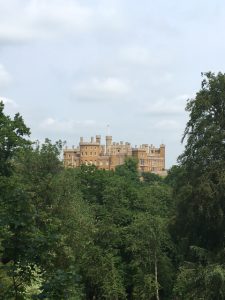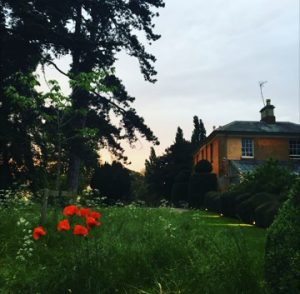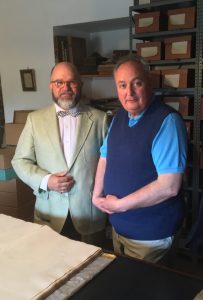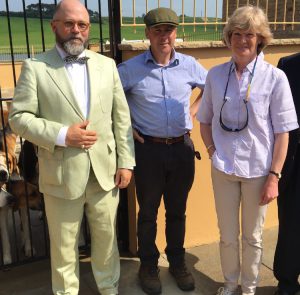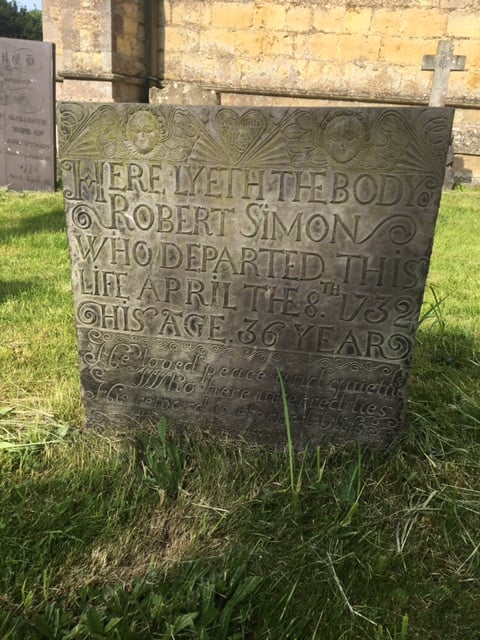My Simons ancestors came from a picturesque region in England known as the Vale of Belvoir (pronounced “Beever,” and meaning “beautiful view,” from the French), found at the intersection of three counties: Leicestershire, Nottinghamshire, and Lincolnshire. I recently had the pleasure of visiting the Vale with my uncle, Herbert Simons, to become acquainted with the towns and villages where our paternal ancestors lived from time immemorial. Records of the Simons family (variously spelled Simon, Simond, Symonds, Simons, etc.) stretch back in the Manor of Langar as far as 1340, when it was noted that William Simond “has one messuage and one bovate for homage and fealty and pays five shillings at Saint Martin’s and Pentecost …”
[V]istas of the Vale and its wide, green fields...
The Simons family continued to live at Langar for centuries, and later for a brief time in Knipton. On our trip, we stayed at the present-day Langar Hall, a charming country inn presided over by a most welcoming and delightful owner, Imogen Skirving. Langar Hall has an assortment of lovely guestrooms, all decorated in traditional style – including one named after a frequent guest, the late novelist Dame Barbara Cartland – overlooking views of the gardens and, beyond, vistas of the Vale and its wide, green fields and gently rolling hills.
My uncle stayed in “Favourites” and I occupied “Lilacs.” Imogen acquainted us with the tradition that the name “Langar Hall” is derived from the Sanskrit word for a place where pilgrims rest and take nourishment. The medieval castle of Langar Hall, long vanished, was home to the Scrope family, “Lords of the North, kingmakers, traitors, Chancellors, and Archbishops.” Henry Scrope, the third Baron Scrope of Masham, is memorialized in Shakespeare’s Henry V: “What shall I say to thee Lord Scroop, Thou cruel, ingrateful, savage and inhuman creature?”
Today’s Langar Hall is a fine country house, pictured here, and is separated by only a few feet from the church at Langar where generations of our ancestors were parishioners and where many are buried alongside the Scropes and others. In the following days, we explored numerous villages and hamlets associated with our ancestors, including Knipton, Muston, Stathern, and others.
...a trove of genealogical surprises awaited us...
The most memorable part of our trip occurred during our visit to Belvoir Castle, seat of the Duke of Rutland – a majestic “fairytale” castle with high turrets, perched high atop a hill amidst a sweeping Capability Brown garden landscape. At the castle, a trove of genealogical surprises awaited us. Our Simons ancestors had long been associated with, and in service to, the Manners family, Earls and then Dukes of Rutland. The present Duke, an avid historian and author of a forthcoming naval history set during the Revolution, had learned of our visit and taken an interest in it, and he graciously invited us to lunch at the castle.
What we did not expect was that he had also arranged, through the assistance of his aide-de-camp, the Reverend Stuart Foster, and archivist, Peter Foden, to show us records of our ancestors from the extensive Belvoir Castle archives. We arrived at the castle at the appointed hour and our jovial hosts proceeded to conduct a full “Who Do You Think You Are”-style experience for us, showing us numerous original records of our ancestors heretofore unknown to us. The most revealing discovery was that an earlier Duke of Rutland had given my ancestor ten shillings to help pay for his emigration to America. That struck a chord. Through our visit in 2016 to “hallowed ancestral grounds,” our family had now come full circle, and had done so as guests of the descendant of the man who helped our ancestor reach American shores.
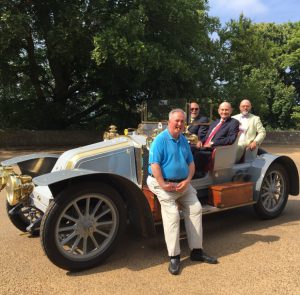 Motoring out in the 1908 Renault. His Grace the Duke of Rutland, center, and top, left to right, Rev. Stuart Foster, Herbert Simons, and Brenton Simons.
Motoring out in the 1908 Renault. His Grace the Duke of Rutland, center, and top, left to right, Rev. Stuart Foster, Herbert Simons, and Brenton Simons.
The discoveries continued. Having pinpointed an ancestral home in nearby Stathern, the Duke drove us down to take a look at a handsome whitewashed house that belonged to my ancestor, Edward Simons. Other surprises were in store for us. After a delicious lunch and much good conversation, we ventured out in the Duke’s 1908 Renault. This grand old automobile, now more than one hundred years old, drove splendidly and whisked us to the Belvoir Hunt, a location on the Duke’s estate where we knew a more recent ancestor, Admatha Simons, had lived.
Here, the lovely Lady Sarah McCorquodale, a Master of the Hunt, and John Holliday, handler of the hounds, showed us the famous Belvoir hunting dogs and the “Duke’s Room” in the kennels, filled with memorabilia – all found in a lovely lakeside setting. It was a perfect day to visit as preparations were underway for a “puppy show” of the hounds the following day for members of the hunt and their guests. (It should be noted that such hunts in England are no longer blood sports, but other traditional activities of a hunt continue at Belvoir.)
The following day, we visited Haddon Hall, home of the Duke’s brother Lord Edward Manners, considered to be one of the most romantic houses in England and a location of many films, including three different versions of Jane Eyre. Our visit to Belvoir Castle was truly magical, and I hope to bring a group of NEHGS members there one day – to stay as guests in the castle itself and explore the historic surroundings – on a heritage tour. I know from firsthand experience, such a visit will be unrivalled for its rich exploration of history, extraordinary hospitality, exquisite artwork and architecture, rural scenery, and a range of country pursuits.
[All] the joys and disappointments that every life brings...
In closing, one of my longstanding recommendations to our patrons over many years has been that beyond genealogical research conducted through records, we should all try to visit the locations associated with our ancestors – whether in the United States or abroad – and learn something of the history, culture, and scenery of the places where our forebears lived and worked, were born and died, and experienced all the joys and disappointments that every life brings. Our trip to the Vale of Belvoir carried out this advice for a branch of my family to whom we had never given much genealogical attention. Happily, it exceeded all our expectations. I hope by sharing this story I inspire at least a few of our members and friends to undertake similar family heritage trips, whether with NEHGS or on their own.
The Simons family especially wishes to acknowledge and thank His Grace The Duke of Rutland for making them most welcome at Belvoir Castle and permitting them access to records in the Castle archives.
Share this:
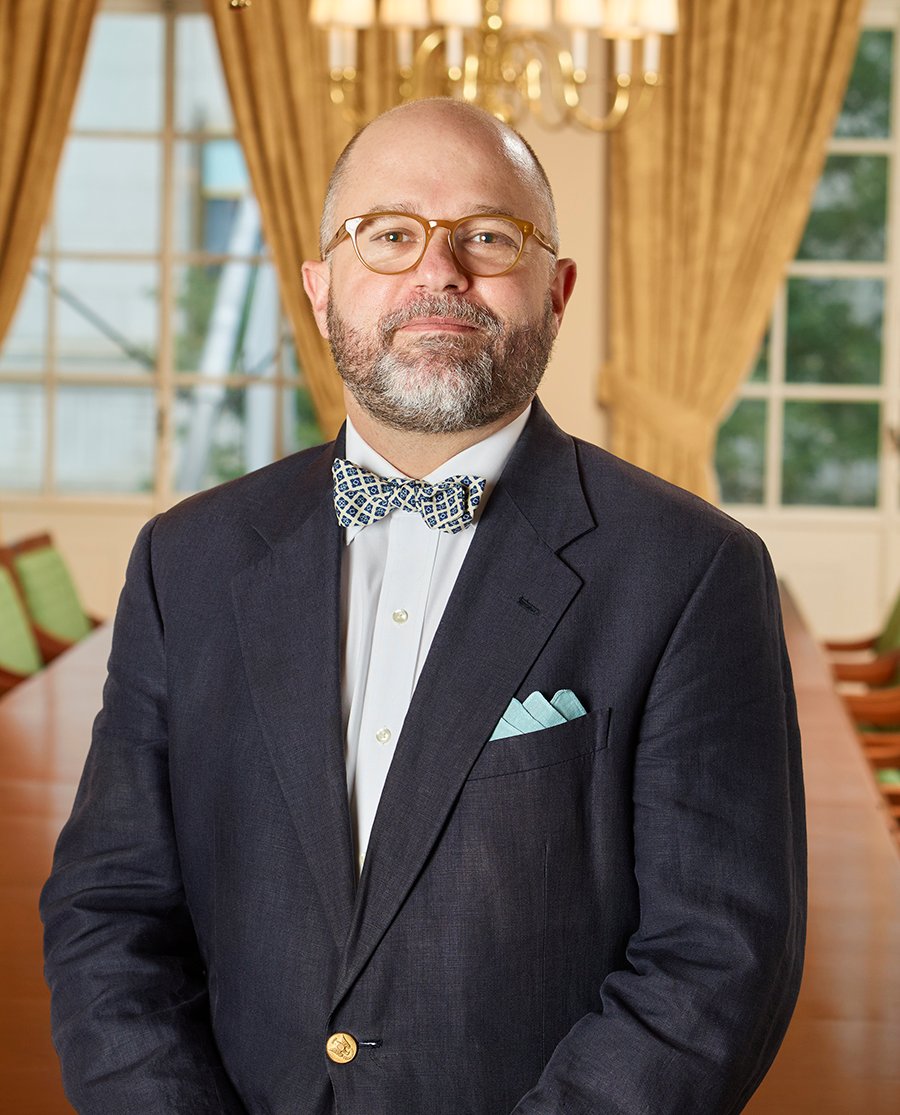
About D. Brenton Simons
Currently piloting a groundbreaking $55 million “Connecting Families, Advancing History” capital campaign for NEHGS, Brenton Simons has led the Society to major growth in its national services and scope and to its pivotal role in the popular expansion of the genealogical field in America. A staff member since 1993 and President and CEO since 2005, he has developed several of the organization’s most popular services, including its website, member magazine, and special publications imprint. In addition, he is the author of several books, including “Boston Beheld: Antique Town and Country Views” and “Witches, Rakes, and Rogues: True Stories of Scam, Scandal, Murder and Mayhem, 1620-1775,” winner of the 2006 Award of Merit from the Association for State and Local History. Most recently he produced with Atlantic Media a short film on NEHGS, “A Farseeing Vision,” recipient of the 2011 Silver Telly Award. His genealogical articles have appeared in The New England Historical and Genealogical Register, The American Genealogist, The Pennsylvania Genealogical Magazine and elsewhere. A graduate of Boston University, he is a member of the Colonial Society of Massachusetts, the American Antiquarian Society, the Club of Odd Volumes, the Society of the Cincinnati, and is a fellow of the Massachusetts Historical Society.View all posts by D. Brenton Simons →
